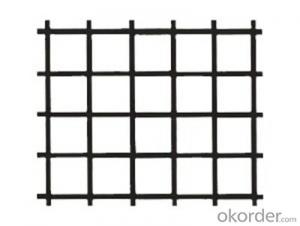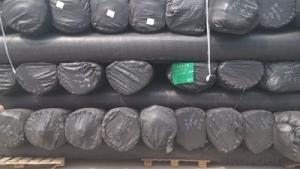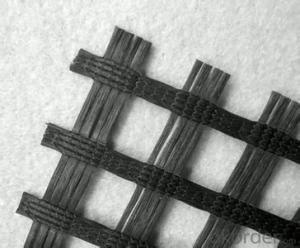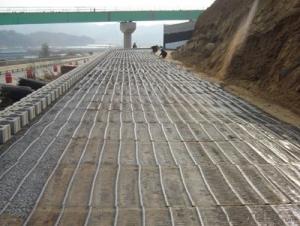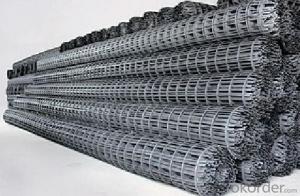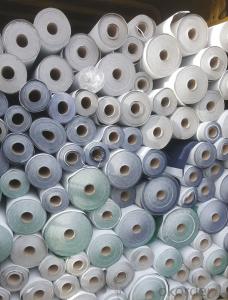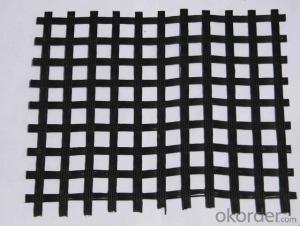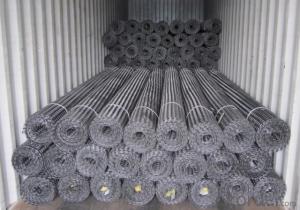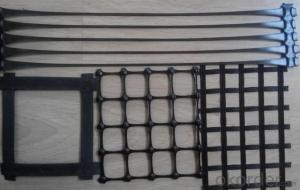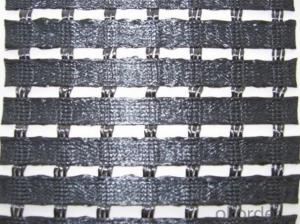Plastic net False roof Biaxial plastic protect-support net used in coal mine
- Loading Port:
- Tianjin
- Payment Terms:
- TT OR LC
- Min Order Qty:
- 88 m²
- Supply Capability:
- 1800000 m²/month
OKorder Service Pledge
OKorder Financial Service
You Might Also Like
Structure of Plastic net False roof for coal mine description :
Made of polypropylene and fire restardant additive by anti-static technology , it can bear high tensile strength .This material has considerable tensile strength in longitudinal and lateral directions. This chain structure can effectively bear and diffuse forces on soil and is applicable to large area permanent load bearing foundation as a reinforce.
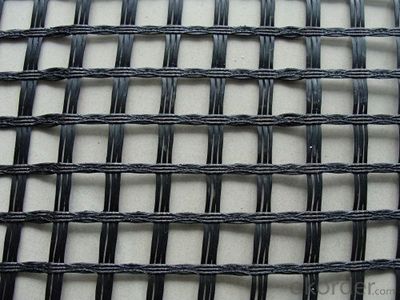
Features of Plastic net False roof for coal mine:
Homogenous structure, low creepage ,anti-aging and resisting acid and alkaline.
Inflaming retarding , anti static ,long lifetime,high safety factor ,high bearing capacity
Application of of Plastic net False roof for coal mine :
Make reinforce treatment for various of soft soil foundation to evenly distribute load stress and reduce unevensettlement , it is easy to wash coal . used in highway ,railway,port,airport, municipacl and projects of supporting in the recovery working face of coal mined and ladeway in the coal mine .
Specification of of Plastic net False roof for coal mine
Width : 1M,2M,3M,4M.
Length: 50m,100,
Color: black
Packaging & Delivery of of Plastic net False roof for coal mine: Each roll is wrapped in a woven bag then into container Or Packed as customers' requests.
Production periods of of Plastic net False roof for coal mine : within 10 days after receiving the deposit
Introduction of CNBM
China National Building Materials (Group) Corporation (CNBM) is a state-owned enterprise in charge of administrative affairs in China building materials industry. Established in 1984, CNBM is a large group corporation of building materials with total assets of RMB 25 billion and a total staff of 30,000. Now CNBM owns more than 200 subsidiaries in and abroad the country, including wholly-owned corporations and joint ventures.
FAQ of geosynthetics :
What is geosynthetics ?
Geosynthetics form a perfect erosion control fabric used extremely widely in civil engineering to stabilize and reinforce slopes and soil under or next to roads, railways, dams, water reservoirs etc.. They can be easily applied which minimizes the time of construction, as well as they limit the resources and materials necessary.
What kinds of geosynthetics we have ?
Non-woven geotextile, geogrids, geocells, GCL, Geomembranes, Geonets, Geocomposites etc .
What is the geosynthetics used for ?
Hydraulic
Lagooning and Water Treatment, Ornamental Ponds, Golf Courses
Aquaculture and Desalination,Water Lagoons,Tanks, Reservoirs, Liquid Waste,Floating Cover Solutions, Drainage and Filtration
Environment
Tailing ponds, Leach mining,Landfills,Landfill Capping,Protection against corrosion,Vertical Barriers
Civil Works
Erosion Control,Secondary Containment,Tunnels,Linear and Surface Works,Consolidation of Margins,Soil Reinforcement,Soil Separation.
Building - Parkings,Roofing,Soundproofing
Structure of Steel-plastic Geogrid with Convex node for mine description :
Made of steel-plastic straps with arabesquitic on the surface , it can bear high tensile strength .This material has considerable tensile strength in longitudinal and lateral directions. This chain structure can effectively bear and diffuse forces on soil and is applicable to large area permanent load bearing foundation as a reinforce.
Features of Steel-plastic Geogrid with Convex node for mine:
Homogenous structure, low creepage ,anti-aging and resisting acid and alkaline.
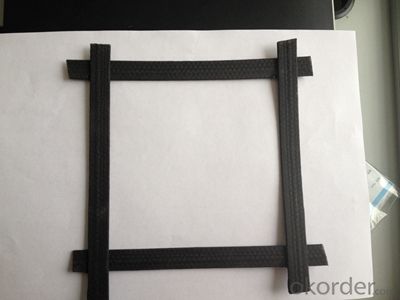
Application of Steel-plastic Geogrid with Convex node for mine :
Make reinforce treatment for various of soft soil foundation to evenly distribute load stress and reduce unevensettlement , it is easy to wash coal . used in highway ,railway,port,airport, municipacl and projects of supporting in the recovery working face of coal mined and ladeway in the coal mine .
Specification of Steel-plastic Geogrid with Convex node for mine
TGSG15-15,TGSG20-20,TGSG25-25,TGSG30-30,TGSG35-35,TGSG40-40,BP15-15MS,HPP20-20MS, HBPP25-25MS,HBPP30-30MS,HBPP35-35MS,HBPP40-40MS
Width : 1M,2M,3M,4M.
Length: 50m,100,
Color: black
Packaging & Delivery of Steel-plastic Geogrid with Convex node for mine: Each roll is wrapped in a woven bag then into container Or Packed as customers' requests.
Production periods of Steel-plastic Geogrid with Convex node for mine : within 10 days after receiving the deposit
- Q:What is the effect of soil type on geogrid performance?
- The effect of soil type on geogrid performance can vary significantly. Different soil types have varying properties such as cohesion, friction angle, permeability, and compaction characteristics, which can directly influence the interaction between the geogrid and the soil. The geogrid's effectiveness in reinforcing the soil, providing stability, and distributing loads can be affected by factors like soil type, particle size distribution, moisture content, and density. Ultimately, the geogrid's performance may be enhanced or compromised depending on the specific soil type it is installed in.
- Q:What are the types of Geogrid
- There are many types of geogrid is about tgsg / convex node tgsg / whole tgsg / glass fiber geogrid
- Q:How do geogrids improve the performance of geocomposites?
- Geogrids improve the performance of geocomposites by adding tensile strength and stabilization to the overall structure. They enhance the load-bearing capacity and reduce deformation, effectively reinforcing the geocomposite system.
- Q:How are geogrids installed?
- Geogrids are commonly installed by first excavating the area where they will be placed, then preparing a level and compacted subgrade. The geogrid is then unrolled and laid flat on the subgrade, ensuring it is properly aligned. It is then secured in place by anchoring it with stakes or pins. Finally, the geogrid is covered with the desired fill material, such as soil or aggregate, and compacted to create a stable and reinforced structure.
- Q:Can geogrids be used in soil stabilization for recreational areas?
- Yes, geogrids can be used in soil stabilization for recreational areas. Geogrids are often used to reinforce and stabilize soil, preventing erosion and improving the load-bearing capacity of the ground. This makes them particularly suitable for recreational areas such as sports fields, playgrounds, or park trails where heavy foot traffic or vehicular loads are expected. By installing geogrids, the stability and durability of the soil can be significantly improved, ensuring a safe and long-lasting recreational space.
- Q:What are the typical applications of geogrids?
- Geogrids are commonly used in a variety of applications, including soil stabilization, reinforcement of retaining walls, slope reinforcement, and erosion control. They are also utilized in road construction, landfills, and mining operations. Geogrids help to improve the strength and stability of soil and other materials, making them an essential component in various civil engineering projects.
- Q:What is the difference between a uniaxial and a biaxial geogrid?
- A uniaxial geogrid has strength in one primary direction, typically along the length of the roll, while a biaxial geogrid has strength in both the length and width directions.
- Q:Are geogrids suitable for use in reinforced slopes?
- Yes, geogrids are suitable for use in reinforced slopes. Geogrids offer excellent reinforcement by providing structural stability, increasing load-bearing capacity, and reducing soil erosion. They are effective in preventing slope failures and enhancing slope stability, making them a suitable choice for reinforced slopes.
- Q:I am a quality inspector, I would like to know what is the standard implementation of Geogrid
- There are many kinds of geogrid, there are several standards
- Q:What are the advantages of using geogrids in construction projects?
- Geogrids offer several advantages in construction projects. Firstly, they provide reinforcement to the soil, increasing its stability and load-bearing capacity. This helps to prevent soil erosion, slope failures, and settlement issues. Secondly, geogrids are cost-effective as they reduce the need for extensive excavation and the use of additional materials. They also facilitate faster construction time as they can be easily installed. Additionally, geogrids are durable and resistant to environmental degradation, ensuring long-term performance and reduced maintenance. Overall, the use of geogrids in construction projects leads to improved safety, enhanced structural integrity, and cost savings.
1. Manufacturer Overview |
|
|---|---|
| Location | |
| Year Established | |
| Annual Output Value | |
| Main Markets | |
| Company Certifications | |
2. Manufacturer Certificates |
|
|---|---|
| a) Certification Name | |
| Range | |
| Reference | |
| Validity Period | |
3. Manufacturer Capability |
|
|---|---|
| a)Trade Capacity | |
| Nearest Port | |
| Export Percentage | |
| No.of Employees in Trade Department | |
| Language Spoken: | |
| b)Factory Information | |
| Factory Size: | |
| No. of Production Lines | |
| Contract Manufacturing | |
| Product Price Range | |
Send your message to us
Plastic net False roof Biaxial plastic protect-support net used in coal mine
- Loading Port:
- Tianjin
- Payment Terms:
- TT OR LC
- Min Order Qty:
- 88 m²
- Supply Capability:
- 1800000 m²/month
OKorder Service Pledge
OKorder Financial Service
Similar products
New products
Hot products
Hot Searches
Related keywords
